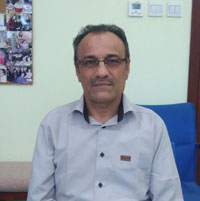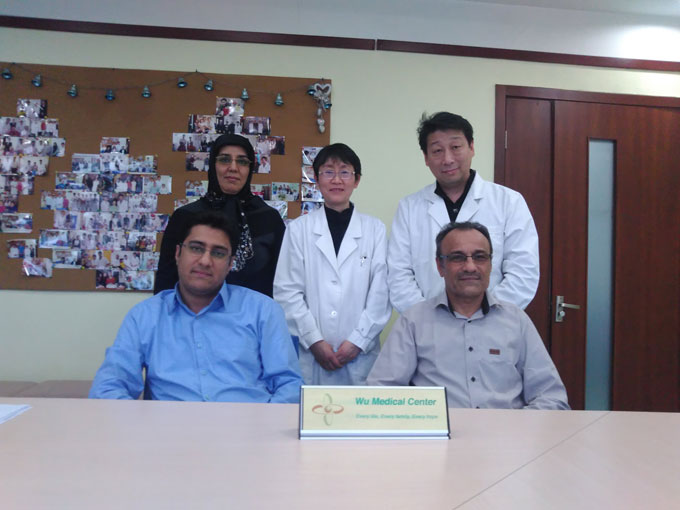Ali Asghar Ettehadi-Amyotrophic Lateral Sclerosis-(Iran)-Posted on April 13th, 2017
 Name: Ali Asghar Ettehadi
Name: Ali Asghar Ettehadi
Sex: Male
Nationality: Iranian
Age: 55Y
Diagnosis: 1. Amyotrophic Lateral Sclerosis(ALS) 2. Hypertension (2 degree, high level)
Date of Admission: November 30th, 2016
Treatment hospital/period: Wu Medical Center/15days
Before treatment:
Ali's right hand had weakness 2 years ago, his right arm was weak too and he also had fasciculation and muscular atrophy. He went to a local hospital, the doctor diagnosed him as having cervical spondylopathy, so he had a surgery 1 year ago. After the surgery his disease became worse, his left arm also had weakness and muscular atrophy. He had an MRI and EMG 6 months ago and was diagnosed with ALS. Riluzole had no effect on him. His disease progressed fast in 6 months, his arms were weaker, his right leg also became powerless and sometimes he choked when he drank. At present, he needs help to eat and put on clothes. He is able to sit up, stand and walk, but his exercise tolerance is bad. He wants a better life so he came to our hospital.
His spirit, diet and sleep pattern are all good, his bladder and bowel functions are normal. He has lost 5 kgs.
Admission PE:
Bp: 130/81mmHg, Hr: 78/min, breathing rate: 19/min, body temperature: 36.7 degrees. Height 172cm, weight 67Kg. Nutrition status is normal and he has normal physical development. There is no injury or bleeding spots of his skin and mucosa, on the right side of his neck there is a post surgery scar of around 5cm. There is no blausucht, no throat congestion, and his tonsils have not swollen. Chest develop is normal, the respiratory sounds in both lungs were clear, breathing sound of lower lungs shows slight weakness and there was no dry or moist rales. The heart beat is powerful with regular cardiac rhythm and no obvious murmur in the valves. The abdomen was soft and pliable, with no masses or tenderness. His liver and spleen were normal, spine is normal and there is no swelling in his legs.
Nervous System Examination:
Patient was alert with clear speech, his mental status is fine. His memory, orientation and calculation ability were normal. Both pupils were equal in size and round, diameter of 3mm, they react well to light and eyeballs can move freely. There is no nystagmus. Bilateral forehead wrinkle and nasolabial fold are symmetrical. His tongue is in the middle with no tongue muscle atrophy and he can show teeth as normal. His tongue can touch his cheek as strongly as normal, he can bulge the cheek strongly and his chewing ability is normal. The soft palate can lift as normal, he can close eyes tightly. There is muscle atrophy of bilateral shoulders, arms, thenars muscles and hand interosseus muscles. His neck is soft, he can his turn head and shrug as normal. Left arm muscle power examination: upper arm adduction muscle 3 degrees; abductor muscles 2 degrees; forearm flexor muscles 3 degrees; forearm extensor muscles 2- degrees, grip force of left hand is 4 degrees. Right arm muscle power examination: upper arm adduction muscle 2 degrees; abductor muscles 1 degree; forearm flexor muscles 2 degrees; forearm extensor muscles 1 degree, grip force of right hand is 1+ degree. Muscle power of legs is 4+ degrees. Muscle tone of the arms is normal and of the legs is higher than normal. The tendon reflex of the arms is abnormal. Patellar tendon reflex is active. Bilateral palm-jerk reflex is positive. Bilateral Hoffmann sign is negative; Babinski sign of both sides are negative. Patient cannot perform the finger to nose test on the left side, the fast alternative test and finger opposite test of left side are clumsy. The right side cannot perform because of the muscle weakness. Right side finger opposite test- can only do the index finger. He can do heel-knee-tibia test as normal. Meningeal irritation sign is negative.
Treatment:
After admission he received related examinations and was diagnosed with ALS and hypertension. He received 3 neural stem cell injections and 3 mesenchymal stem cell injections to repair his damaged motor nerves, replace dead nerves, nourish nerves and improved blood circulation. He also undertook rehabilitation training.
Post-treatment:
After 15 days of treatment the patient’s breathing function improved, the breathing sound of the lower lungs is now stronger than before. The movement ability of his arms has improved. The muscle power of the left arm increased and he can lift the forearm up from the bed. The grip force of the left hand improved. He can perform the finger-to-finger test with 4 middle fingers now, only the little finger cannot do the test. His exercise tolerance has improved, his energy and spirit are both good.

